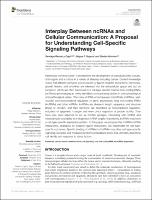| dc.contributor | Vall d'Hebron Barcelona Hospital Campus |
| dc.contributor.author | Ramon y Cajal Agüeras, Santiago |
| dc.contributor.author | Segura Ginard, Miguel |
| dc.contributor.author | Hümmer, Stefan |
| dc.date.accessioned | 2019-06-27T08:49:49Z |
| dc.date.available | 2019-06-27T08:49:49Z |
| dc.date.issued | 2019-04-02 |
| dc.identifier.citation | Ramón y Cajal S, Segura MF, Hümmer S. Interplay Between ncRNAs and Cellular Communication: A Proposal for Understanding Cell-Specific Signaling Pathways. Front Genet. 2019;10:281. |
| dc.identifier.issn | 1664-8021 |
| dc.identifier.uri | https://hdl.handle.net/11351/4158 |
| dc.description | Cancer; Cell signaling; Epigenetics |
| dc.description.abstract | Intercellular communication is essential for the development of specialized cells, tissues, and organs and is critical in a variety of diseases including cancer. Current knowledge states that different cell types communicate by ligand-receptor interactions: hormones, growth factors, and cytokines are released into the extracellular space and act on receptors, which are often expressed in a cell-type-specific manner. Non-coding RNAs (ncRNAs) are emerging as newly identified communicating factors in both physiological and pathological states. This class of RNA encompasses microRNAs (miRNAs, well-studied post-transcriptional regulators of gene expression), long non-coding RNAs (lncRNAs) and other ncRNAs. lncRNAs are diverse in length, sequence, and structure (linear or circular), and their functions are described as transcriptional regulation, induction of epigenetic changes and even direct regulation of protein activity. They have also been reported to act as miRNA sponges, interacting with miRNA and modulating its availability to endogenous mRNA targets. Importantly, lncRNAs may have a cell-type-specific expression pattern. In this paper, we propose that lncRNA-miRNA interactions, analogous to receptor-ligand interactions, are responsible for cell-type-specific outcomes. Specific binding of miRNAs to lncRNAs may drive cell-type-specific signaling cascades and modulate biochemical feedback loops that ultimately determine cell identity and response to stress factors. |
| dc.language.iso | eng |
| dc.publisher | Frontiers Media |
| dc.relation.ispartofseries | Frontiers in Genetics;10 |
| dc.rights | Attribution-NonCommercial-NoDerivatives 4.0 International |
| dc.rights.uri | http://creativecommons.org/licenses/by-nc-nd/4.0/ |
| dc.source | Scientia |
| dc.subject | Tumors - Fisiologia patològica |
| dc.subject | Receptors cel·lulars |
| dc.subject | RNA |
| dc.subject.mesh | Neoplasms |
| dc.subject.mesh | /physiology |
| dc.subject.mesh | Signal Transduction |
| dc.subject.mesh | RNA, Untranslated |
| dc.subject.mesh | /analysis |
| dc.title | Interplay Between ncRNAs and Cellular Communication: A Proposal for Understanding Cell-Specific Signaling Pathways |
| dc.type | info:eu-repo/semantics/article |
| dc.identifier.doi | 10.3389/fgene.2019.00281 |
| dc.subject.decs | neoplasias |
| dc.subject.decs | /fisiología |
| dc.subject.decs | transducción de señales |
| dc.subject.decs | ARN no traducido |
| dc.subject.decs | /análisis |
| dc.relation.publishversion | https://www.frontiersin.org/articles/10.3389/fgene.2019.00281/full |
| dc.type.version | info:eu-repo/semantics/publishedVersion |
| dc.audience | Professionals |
| dc.contributor.organismes | Institut Català de la Salut |
| dc.contributor.authoraffiliation | [Ramón Y Cajal S] Servei d’Anatomia Patològica, Hospital Universitari Vall d'Hebron, Barcelona, Spain. Universitat Autònoma de Barcelona, Barcelona, Spain. Grup de Recerca en Patologia molecular translacional, Vall d’Hebron Institut de Recerca, Barcelona, Spain. Centres d’Investigació Biomèdica en Xarxa en Oncologia (CIBERONC), Barcelona, Spain. [Segura MF] Grup de Recerca translacional en càncer en la infància i l’adolescència, Vall d’Hebron Institut de Recerca, Barcelona, Spain. [Hümmer S] Grup de Recerca en Patologia molecular translacional, Vall d’Hebron Institut de Recerca, Barcelona, Spain. Centres d’ Investigació Biomèdica en Xarxa en Oncologia (CIBERONC), Barcelona, Spain. |
| dc.identifier.pmid | 31001323 |
| dc.identifier.wos | WOS:000463110500001 |
| dc.rights.accessrights | info:eu-repo/semantics/openAccess |

